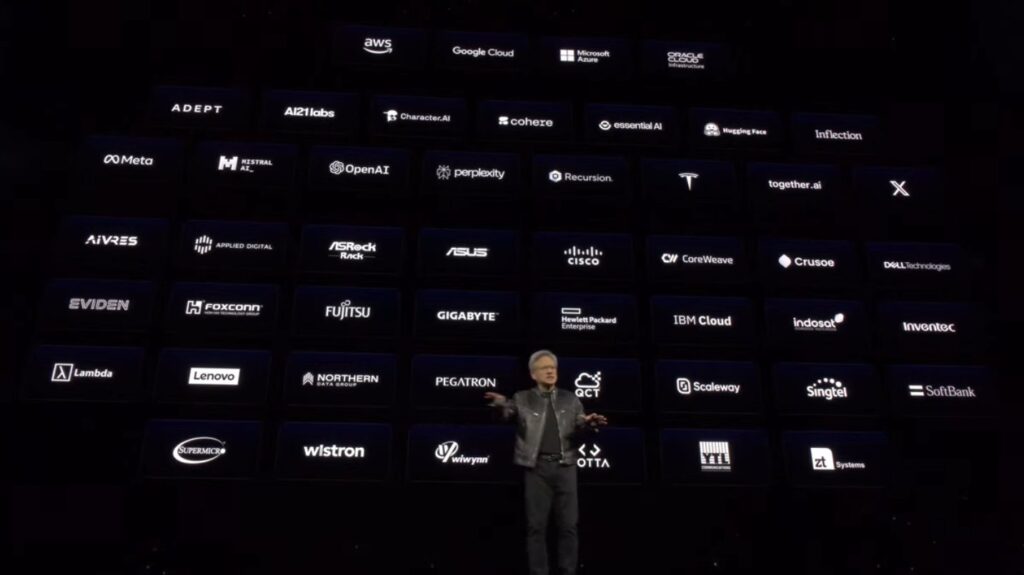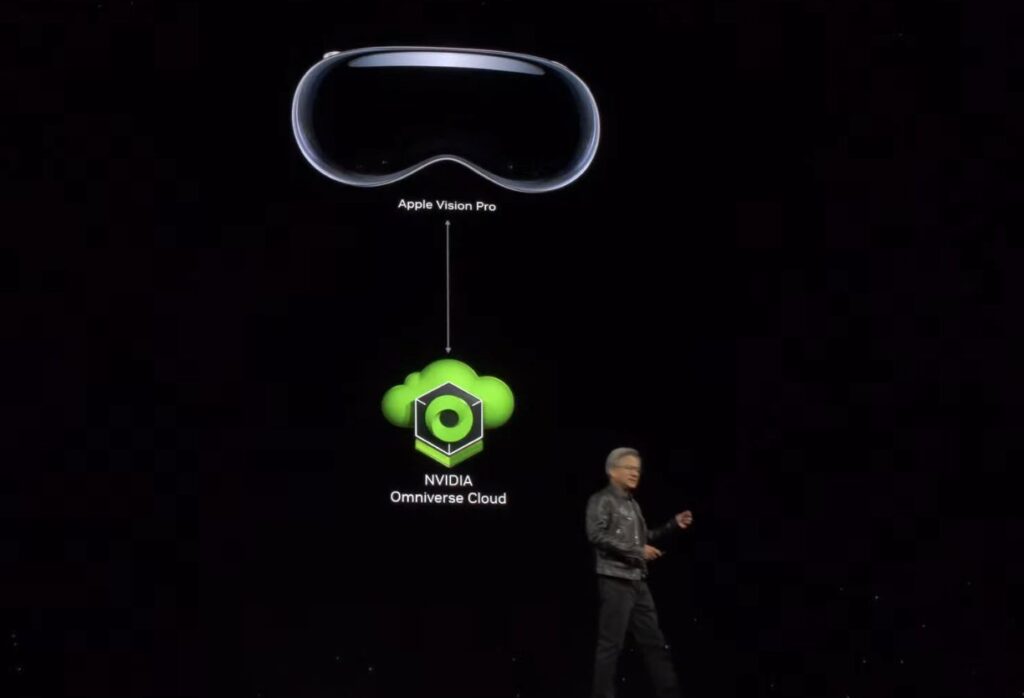Nvidia initiates its GTC 2024 annual developer conference on Monday, with anticipated announcements on new chips and updates on pricing and performance details for upcoming products such as B100, X100, GB200, BlueField, and more.
Nvidia’s newest artificial intelligence chip, the “Blackwell” B200, is set to be priced between $30,000 and $40,000, according to CNBC. These high-end server GPUs, like Nvidia’s H100s, play a vital role in training and deploying extensive AI models, making them highly sought-after assets for tech giants such as Microsoft and Meta, which have made significant investments in these technologies.
GTC 2024

Nvidia has revealed collaborations with Ansys, Synopsys, and Cadence Design Systems to incorporate CUDA acceleration. According to Nvidia’s CEO, the cuLitho project, in collaboration with TSM and Synopsys, utilizes accelerated computing and generative AI to explore new possibilities for semiconductor scaling.
Nvidia’s CEO introduces the ‘Blackwell,’ a significantly powerful GPU, marking it as their most potent one to date. Additionally, they unveil the Blackwell-Powered DGX SuperPOD and new switches designed specifically for trillion-parameter GPU computing and AI infrastructure.

Nvidia has achieved a thousandfold increase in compute power over the past eight years.

Nvidia’s CEO announces that training a GPT MoE-1.8T model within 90 days will now only necessitate 2000 Blackwell GPUs, a significant efficiency leap from the previous 8000 GPUs required with Hopper, marking a fourfold improvement.

Nvidia emphasizes a roster of clients and collaborators, including major players such as Amazon, Oracle, Microsoft, and Google, gearing up to integrate its cutting-edge GPU, ‘Blackwell’.

Nvidia reveals the Earth Climate Digital Twin to predict climate change. CEO Jensen discusses health-related topics such as proteins, genes, and brain waves, emphasizing the digitization of various aspects for comprehensive understanding.
Nvidia and Microsoft join forces to advance generative AI for businesses. Microsoft Azure will integrate the NVIDIA Grace Blackwell Superchip to elevate AI capabilities.
Access to NVIDIA Omniverse Cloud APIs on Azure is now available, enriching the ecosystem of industrial design and simulation tools. Additionally, the integration of NVIDIA DGX Cloud with Microsoft Fabric streamlines AI model development for increased efficiency.
Microsoft Copilot receives an upgrade through the integration of NVIDIA’s AI and computing technology. Additionally, new NVIDIA generative AI microservices are introduced on Microsoft Azure AI, catering to the enterprise, development, and healthcare industries.

Nvidia unveils the initial batch of companies granted access to the new generative AI microservices within NVIDIA AI Enterprise 5.0, featuring Adobe, Cadence, Snowflake, CrowdStrike, Getty Images, SAP, ServiceNow, and Shutterstock.
Collaborations include:
– SAP: Collaborating to develop copilots.
– ServiceNow: Creating assistants.
– Cohesity: Developing Generative Agents.
– Snowflake: Building copilots with NIMS.
– NetApp: Implementing ChatBots and Copilots.
– Dell: Enhancing Chatbots.
Nvidia unveils the release of Omniverse Cloud APIs, designed to drive the development of advanced industrial digital twin software tools. This will facilitate the creation of intricate and extensive digital twin solutions across diverse industries.

Nvidia’s CEO announces that Omniverse Cloud can now stream to Apple Vision Pro.

Nvidia unveils a collaboration with BYD, recognized as the world’s largest EV manufacturer, as they integrate Nvidia’s Thor platform for autonomous vehicles into their upcoming models.

Nvidia introduces Project GROOT, with the goal of transforming humanoid robotics through a versatile foundation model. This initiative involves the introduction of Jetson Thor, a computing system for humanoid robots powered by the Nvidia Thor SoC, along with significant enhancements to the Nvidia Isaac robotics platform.
GROOT empowers robots to comprehend natural language and acquire human-like movements, enhancing their capacity to navigate and engage with their surroundings. Demonstrations showcase robots accomplishing tasks, highlighting the project’s potential to advance artificial general robotics.
Nvidia’s platform will assist firms such as 1X Technologies, Boston Dynamics, and XPeng Robotics, with 1.3 million users already involved in Nvidia’s robotics offerings.

SoundHound partners with Nvidia to provide on-chip voice AI, enabling in-vehicle generative AI responses independently, without requiring connectivity.
CFO of NVIDIA mentioned that new products are expected to be released later this year. Additionally, they noted the possibility of supply limitations.
Jensen Huang of Nvidia asserts that addressing AI hallucinations is feasible, and predicts that achieving artificial general intelligence is within a five-year timeframe.
Despite concerns about a strained U.S.-China relationship, Nvidia’s CEO, Jensen Huang, minimized the possibility of a catastrophic scenario. Nvidia intends to continue its partnership with Taiwan Semiconductor Manufacturing Co. for cutting-edge chip manufacturing, such as the upcoming Blackwell GPU. Amidst geopolitical complexities, the company remains committed to advancing its AI chip technology.

Meanwhile, Bitdeer Technologies Group has successfully deployed and validated its NVIDIA DGX SuperPOD H100 system ahead of schedule, marking a milestone as the first Asian cloud service platform to provide this cutting-edge computing service. This collaboration with NVIDIA amplifies Bitdeer’s AI capabilities, offering scalable and efficient AI and HPC solutions across diverse industries. This achievement enables organizations to expedite workflows, explore novel opportunities, and broaden accessibility to AI technology.
Hitachi Vantara, a subsidiary of Hitachi Ltd., has unveiled a partnership with Nvidia aimed at creating a fresh range of industrial AI solutions. This collaboration focuses on crafting AI frameworks to streamline time to market and simplify the process of constructing and implementing infrastructure for generative AI.
Hitachi Vantara is set to build a lineup of solutions known as Hitachi iQ, which will drive precise AI results by incorporating industry-specific features into its AI solution framework. This strategy ensures organizations achieve tailored and pertinent outcomes.
Siemens has strengthened its collaboration with NVIDIA by incorporating NVIDIA Omniverse Cloud APIs into its Xcelerator platform. This integration enhances the utilization of AI-driven digital twin technology, facilitating the development of immersive visualizations and more authentic product simulations. This partnership seeks to expedite computing capabilities, leverage generative AI, and expand AI-powered digital twin applications throughout the Siemens Xcelerator portfolio, transforming the processes of product design, manufacturing, and maintenance.
Johnson & Johnson (JNJ) has joined forces with Nvidia to advance artificial intelligence (AI) in surgery, aiming to expedite secure, live analysis of surgical data, influencing surgical decision-making and training. JNJ’s stocks have experienced a marginal decline in the last six months, contrasting with industry declines and S&P 500 growth. The healthcare AI market is projected to expand substantially due to increased data generation, cost efficiencies, and enhanced computing capabilities.
Nvidia Corp. is teaming up with Hippocratic AI to create AI nurses, priced at $9 per hour, a substantial saving compared to human counterparts charging $90 per hour. These AI nurses, featuring the AI agent “Rachel,” aim to transform healthcare by delivering instant medical guidance while collaborating with human physicians. This initiative addresses challenges within the nursing sector and has the potential to disrupt the industry with its affordable alternative.
Bringing you the latest updates on finance, economies, stocks, bonds, and more. Stay informed with timely insights.

















Hilarious you think a doctor will help you navigate the health care system